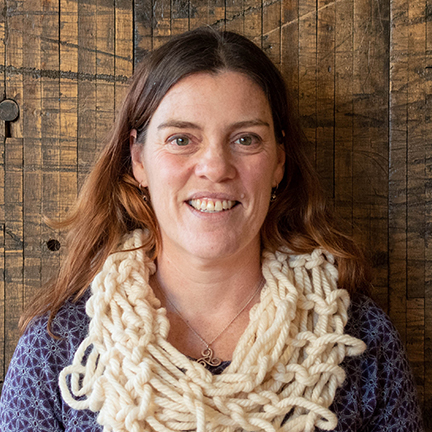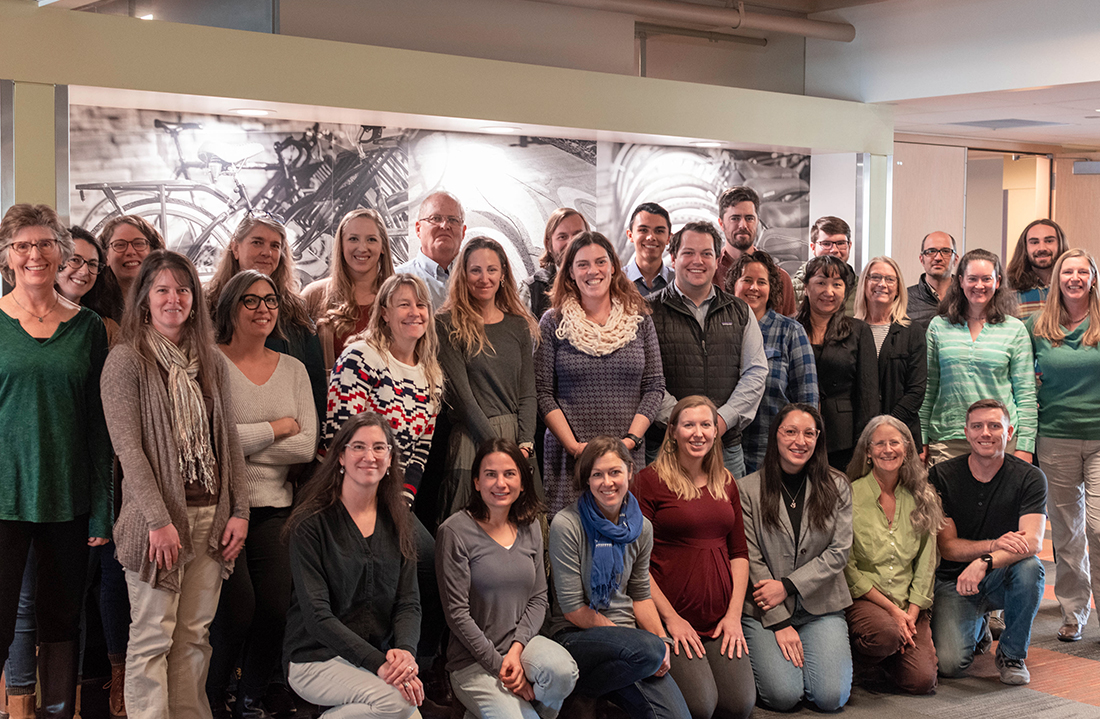BY JODI PETERSON
Mindy Clarke and Jennie Anderson manage CEMML’s Climate Adaptation and Management Planning Program (CAMPP), which provides multi-disciplinary analysis of the threats that Department of Defense installations face from climate change. The program draws on expertise from CEMML and CSU scientists, including ecologists, cultural resource managers, hydrologists, wildlife biologists, and social-ecological systems experts.
The CAMPP team has modeled climate-change scenarios and assessed vulnerability to potential climate impacts for over 120 Air Force sites around the world. They are now conducting assessments for natural resources at Army and Navy installations and cultural resources at Air Force installations. They also provide climate-literacy training for installations to build their capacity to use climate science and adapt their management of natural resources.

Dr. Clarke has been a principal investigator at CEMML for 7 years. Here, she discusses CAMPP, how it began, and where the team is headed.
CEMML: How did CEMML’s climate change adaptation program begin?
CLARKE: It was a response to a 2016 directive from the Department of Defense, which required each installation to incorporate climate change planning into their natural resource management plans. The Air Force Civil Engineer Center reached out to us and said, can you do that? They gave us a large award to start the work, and (former CEMML Associate Director) Liz Caldwell pulled together a team and brought me on to be the project manager. I worked with the team to put together the methodology for modeling and assessing potential climate impacts on the military mission. It was an interdisciplinary effort, and it took us about a year to gather all of the data that we needed and get everybody on the same page, and then over the next year we did assessments of climate impacts at about 100 Air Force sites, mostly in the U.S. We learned a ton in that process and by the end of that project, we had a really good functional team.
Since then, we have slowly been growing the program out with the focus of being the one-stop climate adaptation shop for DoD. So when military bases come to us with climate science needs beyond what CEMML offers, we turn to CSU first, and if nobody at CSU can do it, we identify resources from other places that can meet the military’s needs. Then our team makes sure that whatever product is produced is appropriate, of high quality, and meets the needs of our military sponsor.
CEMML: Has your approach changed based on what your team has learned from developing these reports?
CLARKE: We’ve gotten a lot of feedback that helps us understand what the challenges are for installations and what capacities they have, technical and otherwise, to engage with climate change. And so we’ve identified key areas where we can help installations be efficient in how they address climate change issues, because there’s a huge push forward on climate change from the current administration. But DoD has always been very forward thinking on climate change. So there’s a big push for a lot of different activities around climate change adaptation and climate change mitigation across the military. We’ve been working with DoD natural resource managers to identify the types of help they need and make sure that their climate work is as effective as it can be. Some of the managers have gained a lot of knowledge about climate change through their own work, and then some of them haven’t yet had the opportunity to engage in that. So we’ve been trying to simplify the basic components of what installations need to know so that then when they go to climate service providers like CEMML, they understand the information that they’re getting and can then make well-informed decisions.
With so many people jumping into the climate space, there are some snake-oil peddlers who promise to do things that the science doesn’t really support. And while they can indeed do those things, they are not backed by science, so we try to help military installations understand the state of climate science and what we can do and can’t do based on that.
We also try to address how climate change considerations could evolve. Sometimes we identify vulnerabilities that an installation may want to start addressing now rather than waiting for the climate to change to a situation where they don’t have any options anymore. Natural resource managers already have all of the skills that they need to address these changes; they just need to change how they are structuring the problems so that they are focusing on future projections and taking a more proactive approach. We are trying to help them build on the skills that they already have.
CEMML: What’s an example of how installations need to start thinking about a potential climate change impact and what they can do now to head that off?
CLARKE: Coastal habitats, particularly for shorebirds, are one of the most sensitive habitats that we have. The typical reactive shorebird management activities are doing things like ensuring there’s sufficient food resources and ensuring that eggs and chicks don’t get trampled during nesting season. And there’s a lot of monitoring of what habitat the species uses currently to target management activities to those preferred nesting and feeding sites along the shore. That’s the habitat that natural resource managers want to protect. Well, when you incorporate climate change into it, we have to look at things like, is that preferred habitat going to be underwater by 2030? Maybe there’s five acres of suitable habitat today and currently the installation manages two acres. Well, if half of those two acres is going to be inundated by sea level rise, now these birds are down to one acre. So as the climate changes, we may need to proactively start managing more of their suitable habitat to provide a buffer, so that more good habitat is available even if they lose the habitat that they already have.
CEMML: What’s the process of putting together a climate change report for an installation? Where does your team get the data and information you use?
CLARKE: Our first priority is the philosophy that we use publicly available data, unless there’s absolutely nothing that’s publicly available, because we think that it’s a strength of our analysis that anybody can reproduce our methods and results. So our process is completely transparent. Even if we developed new methodologies and new data, we wouldn’t own it because it’s funded by the government, so there’s no point in us creating anything proprietary. We also have a unique set of expertise because I don’t know of any team who has as much experience applying climate adaptation to installations as CEMML’s. We have knowledge and expertise that has taken years to develop.
So we start with public data. We start with the climate models that are used by the Intergovernmental Panel on Climate Change, and all climate service providers have access to the same data sets. We just slice and dice them differently, and ours is sliced and diced so that we are looking specifically at the smallest scale available to make our work relevant to the installation, which is an added strength of what we do because nobody else is really looking at specific installations. They’re looking at states or regions, but not the installation level.
We worked with the Air Force to develop our future projection timeframes based on the installation’s planning horizon, which also makes our product unique. You’ll see a lot of climate analysis that uses 2050 and 2100 for projecting future impacts. Well, for the DoD, 2100 is too far out for funding and planning decisions, and they need to look at closer decades. So that’s why we’ve focused on 2030 and 2050 instead.
We extract a number of bioclimatic variables from that public data to create installation-specific climate projections, and then we determine how those changes could affect the size of precipitation events in the future, we do channelized flood modeling for the installation, and if applicable we also model sea-level rise.
We’ve started partnering with NatureServe (a nonprofit that collects and analyzes biodiversity data in North America) to assess ecosystem vulnerability because they have the best models, the best approach, and strong scientific expertise. So that’s been a really nice partnership. They provide us with a lot of data and then we interpret the information.
We now have done three phases of these reports and each time we start a new phase, we identify what we want to improve and what we can add. Climate science has evolved greatly in the last six years, and the science that was available in 2016 is a fraction of what’s available now, so we want to provide the most up-to-date analysis that we can. We provide a very robust reference for the installation should they choose to act on any of the climate-related suggestions or adaptation projects that we have provided.
CEMML: What’s your approach to providing climate change information to an installation?
CLARKE: We start wherever they are. We are here to meet their needs. Sometimes we’ve built trust with an installation by focusing on making sure they are in compliance with DoD regulations about climate-change planning. Once they realize how much our team can help them, they tend to open up to us. We are very cognizant of the fact that the installations have their own expertise in natural resource management and we want to add value to that. So once we get the message across that we are there to help them reach their goals and that we don’t have any agenda of our own, they tend to engage with us in collaborative and constructive ways.
After the climate change vulnerability assessment reports are complete, our management planning experts start working with installations to develop goals, objectives, and projects for their management plans. We help them understand what the funding priorities are from the DoD level. We can help them take the climate information we’ve provided, look at what their needs are, and then strategically develop projects that have a higher likelihood of being funded. From what installations have said, that has been really useful in their decision-making process and structuring long-term natural resource management activities. We work to identify not only what projects are coming up next, but also what the trends are and what the installation needs are so that we can be forward thinking. My collaborator, Jennie Anderson, another CEMML PI, leads the management planning efforts.
CEMML: What is your vision for the program’s continued evolution?
CLARKE: The vision is that not only do we provide support through our internal capacities, but we also serve as kind of a clearinghouse to promote other activities of the university, promote other partnerships, and create those openings. We help promote the skill sets available at other places in the university, like the CSU Soil Carbon Solutions Center.
As our program has expanded, we have developed a pretty deep bench of nearly 30 people with specialized expertise. But we don’t pretend to be the experts in all aspects of climate adaptation and mitigation, and to help DoD units in areas where we don’t have expertise, we reach out to our university colleagues and we facilitate communication between those researchers and military resource managers.
What we want to do is help the military identify their climate adaptation and mitigation needs, and then help the practitioners structure what they’re doing so that it meets the military’s needs. That’s the future that we hope for.
 Some members of CEMML’s Climate Adaptation and Management Planning Program during a staff training event in December 2022. Courtesy Mindy Clarke.
Some members of CEMML’s Climate Adaptation and Management Planning Program during a staff training event in December 2022. Courtesy Mindy Clarke.